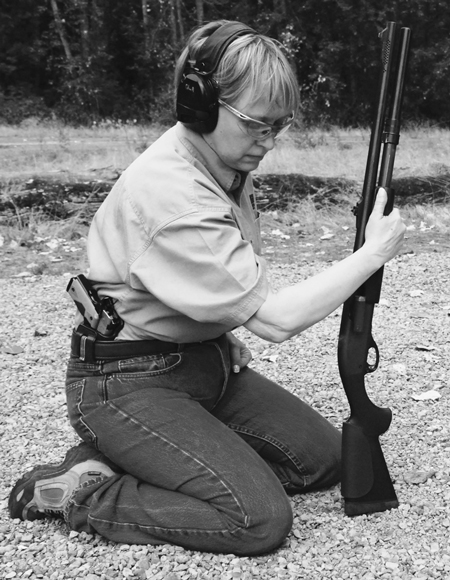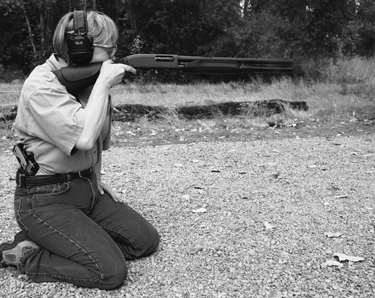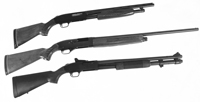

While the handgun is an easy firearm with which to learn shooting skills, it is not the most powerful defensive weapon one may choose. The home defense shotgun lays claim to that title.
The handgun comes first to mind in discussion of defensive firearms because the pistol’s small dimensions provide the portability and concealability valued by the individual legally entitled to carry a concealed firearm for personal defense. Other defensive functions, including home defense or protection of a place of business, may be served as well or better by a light rifle or a shotgun.

Shotguns have many great characteristics for the ensconced defender — that is, for one who must remain in position and fight instead of fleeing. The shotgun is a common home-defense and sporting firearm that not so many years ago also saw extensive use in police service. We benefit from the shotgun’s long history since it provides many, many variations from which to choose, lots of ammunition options, and can fine tune the shotgun’s fit with a wealth of accessories.
Terminology
With shotguns, the term “gauge” is similar to our use of “caliber” for handguns and rifles. Unlike caliber, with gauge the larger the number, the smaller the bore. Historically, gauge was defined by the number of solid balls the same diameter as the inside of the barrel that could be made from a pound of lead. Thus, the 10-gauge shotgun is larger than the 12-gauge, which is larger than the 20-gauge. Even smaller are the rather uncommon 24- and 28-gauges. The exception is the smallest of all, the .410 shotgun, which is expressed by the measurement (caliber) of its nominal bore size.
The most common shotgun gauge is the 12-gauge, the dominant shotgun choice in law enforcement. For home defense, the smaller 20-gauge shotgun does the job just fine, and this smaller shotgun is often found in use by smaller-statured birdhunters, as well.
The shotgun is unique in its ability to fire shells containing varying numbers of pellets, different sized shot, slugs, and in some guns even shells of several lengths for a magnum or standard charge. It is really quite a versatile defense tool that can be a lot of fun to train with.
The great advantage of the home-defense shotgun is its simultaneous delivery of multiple projectiles at reasonably high velocities. The effect of 20 .25-caliber pellets of #3 buckshot moving at around 1200 fps from a 20-gauge shotgun is vastly more devastating than firing nine single shots of .25 caliber handgun ammunition into an assailant.
When innocent life is threatened, the overwhelming concern must be to stop the attack quickly. At that instant, we are not worried about the eventual survival or demise of the assailant; seeking only an immediate cessation of the attack. Used to stop violent attack, the shotgun is effective indeed when fired with accuracy and skill.
Pros and Cons
The home-defense shotgun is best employed when the home’s occupants can take refuge in a prearranged, protected area, and defend themselves from a single point. The multiple projectiles that make the shotshell so effective are equally dangerous to innocents if they miss the intruder and penetrate walls of occupied rooms. Handgun ammunition poses the same danger, of course, but this hazard is compounded by the multiple projectiles each shotshell contains. Later, we’ll discuss shot patterns, how they spread over varying distances, and the penetration potential of various shotgun loads.
As a defensive weapon, the shotgun seems best suited to childless couples or single occupants, or in home layouts where those to be protected are sure to be clustered behind the defender. The shotgun works well if those responsible for home defense take their position at the head of a hall that precedes all other bedrooms, or can defend the family from the top of a staircase, if all the residents are ensconced on the upper floor.
In any home-defense plan, the downfall of the shotgun will be its weight and length. If you must hold a home intruder at gun point with the shotgun for more than 10 or 15 minutes, its weight will become tiresome indeed. 12-gauge shotguns weigh around 7 lbs.; 20-g. shotguns average 5 lbs. Compare that weight to your 1- to 2-lb. handgun when deciding which home-defense tool will work best for you.
Shotgun Myths
You may have read elsewhere that the shotgun can be fired accurately without taking time to align the sights. This is not true. At home-defense distances like five yards, it is entirely possible to completely miss a human-sized target if the sights are not used! Skill with the shotgun, like any other defensive firearm, requires competent instruction, dedicated
practice, sighted fire and trigger control. When these skills are mastered, it becomes a devastating weapon.
Others have written that one big disadvantage of the shotgun is that it requires two hands to operate. This is not entirely true, either. Certainly, with only one hand, it is faster and easier to fire a pistol than a shotgun. Still, with advanced training, one can operate the shotgun with just one hand, including cycling a pump shotgun.
Shotgun Selection

Just as handgun fit is crucial to accuracy, the shotgun must also fit the shooter. Women face a challenge in finding shotgun stocks that are sufficiently short. One great advantage to the 20-gauge shotgun is the ready availability of “youth models,” short-stocked shotguns that operate just like the full-sized models. Most full-sized shotguns have a 14″ or longer length of pull (the measurement from end of stock to trigger), while youth models usually go at 13 inches.
When the shotgun’s stock is too long, the shooter’s support arm is nearly hyperextended, instead of bent at the elbow for strength needed to hold up the shotgun and pull it in tightly into the shoulder. Without strong support from the non-shooting hand, the shooter leans back at the waist, attempting to balance the weight of the shotgun over her hips. If merely holding the gun was required, this would succeed; however, when firing the shotgun, a shoulders-back stance is disastrous.
When strong stance is compromised, the recoil’s effects are intensified. If the overlarge shotgun is a pump action, working the slide can pull the shotgun out onto the shoulder joint, where it must be repositioned before the next shot, or it will recoil painfully into the joint.
By now, you can see the necessity of proper stock fit. As a general rule, when the butt of the shotgun is held in the elbow crook of your bent arm, the first joint crease on your index finger should fully contact the trigger. The 20-gauge youth shotguns fit this dimension perfectly for many women and should be seriously considered when buying a home-defense shotgun.
If a youth model is too short, you can add a recoil pad like the Pachmayr Decelerator, which not only dampens the felt recoil enormously, but also adds length to the stock.
Alternatively, the entire stock can be replaced with one with a 13″ length of pull, like those sold by SPEEDFEED®2 or the rubber overmolded 12″ stock by Hogue.
Requiring no gunsmithing to install, replacement stocks screw onto the Remington pump or semi-auto shotguns with relative ease. A more expensive alternative is to buy a full-sized shotgun with a wood stock, then pay a gunsmith to cut the stock to size. I have done both, and swear by my short little Hogue stock.
This is an excerpt from Personal Defense for Women.

Next Step: Get your FREE Printable Target Pack
Enhance your shooting precision with our 62 MOA Targets, perfect for rifles and handguns. Crafted in collaboration with Storm Tactical for accuracy and versatility.
Subscribe to the Gun Digest email newsletter and get your downloadable target pack sent straight to your inbox. Stay updated with the latest firearms info in the industry.

![Best Concealed Carry Guns In 2025 [Field Tested] Wilson Combat EDC X9S 1](https://gundigest.com/wp-content/uploads/Wilson-Combat-EDC-X9S-1-324x160.jpg)


![Best 9mm Carbine: Affordable PCCs [Tested] Ruger Carbine Shooting](https://gundigest.com/wp-content/uploads/Ruger-Carbine-Shooting-100x70.jpg)
![Best AR-15: Top Options Available Today [Field Tested] Harrington and Richardson PSA XM177E2 feature](https://gundigest.com/wp-content/uploads/Harrington-and-Richardson-PSA-XM177E2-feature-100x70.jpg)
